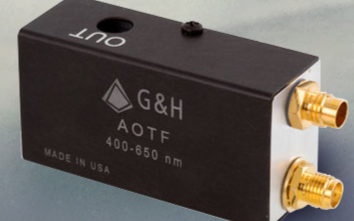January 15, 2021
2409
Acousto-optic equipment is essentially a device composed of one surface of an optical unit (crystal) connected to a radio frequency signal generator (generating 10-100MHz ultrasonic waves). Due to the elastic effect of light, ultrasonic waves refract the medium. The frequency produces sinusoidal disturbance, which makes the refractive index of the medium change periodically, forming a volume grating structure. The period of the grating is determined by the speed of sound and frequency. When the wavelength of the light matches the frequency of the driver, the light and the grating interact to form a strong first Diffraction effect.

The principle of the acousto-optic tunable filter (AOTF) is based on the Bragg diffraction and inverse piezoelectric effect caused by the acousto-optic effect. The Bragg phenomenon is a phenomenon in which a specific wavelength of a specific crystal is reflected at a specific incident angle to form a concentrated peak. The Bragg phenomenon is suitable for infrared and visible ultraviolet light, electron diffraction, neutron diffraction and X-ray diffraction. The inverse piezoelectric effect refers to the phenomenon of mechanical deformation of the crystal when an alternating electric field is applied to the crystal.
Since the Bragg phenomenon requires a specific wavelength to correspond to a specific crystal, then the specific wavelength refers to the wavelength to be used filtered from the wavelength of the polychromatic light. Due to the principle of acousto-optic effect, different ultrasonic frequencies correspond to crystals with different periodic changes in refractive index. It is a specific crystal, which means that a specific wavelength corresponds to a specific ultrasonic frequency, and the specific angle needs to be adjusted by itself. For the acousto-optic tunable filter (AOTF), all incident wavelengths are at the same incident angle, so the white light source is incident Adjust the angle once and fix it. You can filter out the used wavelength by controlling the ultrasonic frequency added by the driver, or you can control multiple channels to achieve multi-channel wavelength output. Because it is based on the principle of acousto-optics, the light of all channels can be switched and modulated by external modulation signals. And intensity modulation. The wavelength bandwidth resolution of the acousto-optic tunable filter (AOTF) is generally not particularly high. Generally, it is a wavelength bandwidth of one nanometer to several nanometers, which will vary according to the device and the wavelength used.
Acousto-optic tunable filters (AOTF) are generally used in optical communications, scanning spectrometers, hyperspectral imaging systems, radiometers and other fields. Acousto-optic tunable filters (AOTF) have higher performance than ordinary grating monochromators. Luminous flux has significant advantages in many systems that require luminous flux, and can modulate the light of each channel, but the acousto-optic tunable filter (AOTF) also has certain disadvantages. The spectral resolution is not excellent enough and it is sensitive to deflection. And other disadvantages. Therefore, specific special applications still need to be determined according to specific conditions, and specific devices are matched to specific applications.
The tunable filter provided by Xinte Optoelectronics has excellent performance, the bandwidth resolution is less than 0.1%, and the aperture size can reach more than 25mm. It can be used to quickly and dynamically select specific wavelengths from broadband or multi-line sources. When the ultrasonic beam and the light beam meet specific matching conditions, diffraction occurs. Therefore, key filter parameters such as wavelength, modulation depth, and uniform bandwidth can be electronically controlled to provide fast (usually μs) dynamic random access optical filtering.